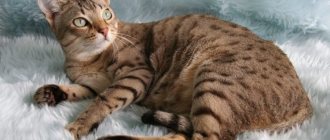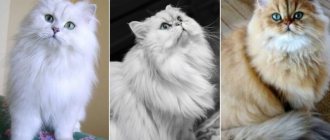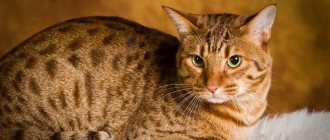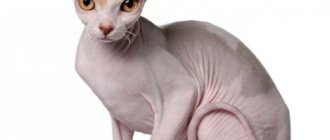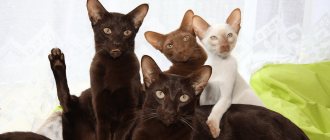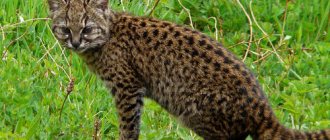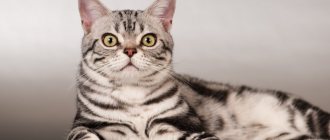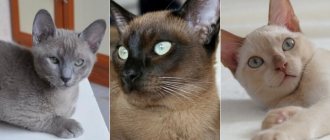Combing
For cats that do not participate in exhibitions, slicker combs cannot be used. They are used only by a professional groomer: for exhibition preparation of hair on certain parts of the animal’s body - on the face and paws. For constant grooming of your Persian cat, it is better to use a steel comb with long, non-sharp teeth.
In order for the procedure of combing fur to become habitual for a Persian, the animal must be accustomed to it from the age of a kitten. Caring for Persian kittens begins with this procedure. For a kitten, combing is more like a game, so the first procedures can be carried out in the form of a game.
The kitten should be placed on its back and first scratched on its neck, belly, and paws. Then, turning him over on his stomach, gently scratch his head and back. It is necessary to repeat the combing procedure daily only during the period of accustoming to it. Then do it regularly 1-2 times a week. Having secured combing, you can move on to teaching him to bathe.
Combing wool
Many experts believe that you need to comb your cat with a so-called slicker brush, but this is one of the most common mistakes. Slickers can be used only in exceptional cases, and it is better not to use such extreme options for grooming in household use. Caring for the hair of a Persian cat begins with the purchase of a good comb, preferably one that is made of steel and whose teeth are long, but not sharp, so as not to injure the animal.
It is better to accustom your animal to daily brushing from a very tender age. If you follow simple rules, caring for your animal will become a habit and will not cause negative emotions.
No cat will immediately sit still and wait to be brushed.
Bathing
Caring for a Persian cat means not only brushing, but also bathing. The optimal number of water treatments for a Persian cat is once every 3-4 weeks. During the molting period, bathing can be made more frequent to prevent the fur from matting.
For bathing, you need to choose the appropriate shampoo for long-haired cats. Usually, Persians, with the right approach to this procedure, quickly get used to it and tolerate it calmly. It is important that the water is warm and does not get into the animal’s ears.
After wetting the cat with water, apply a small amount of shampoo to its fur and foam it over the entire surface of the animal’s body. After washing off the foam, you need to rinse the wool thoroughly with a shower. It is important not to leave any shampoo residue on the coat. Then the whole effect of bathing will go down the drain.
The next step in bathing is drying the coat. First, most of the moisture must be removed with a towel, wrapping the animal in it. Then dry it completely with a hairdryer. An adult animal must also be accustomed to this device from the age of a kitten. Usually adult Persians, accustomed to bathing, endure all its stages, including drying, patiently and with dignity.
A prerequisite for bathing Persian cats is to prevent colds. Therefore, after the water procedure, it must be kept warm, avoiding drafts for 10-12 hours.
History of the origin of the Persian cat breed
global $ads_google;
//data-ad-slot=”2475549904″ $ads_google = empty($ads_google) ? false : true; ?> if ($ads_google == false) {?> $ads_google = true; ?> } ?> Traveling through the Persian province of Harassan, the Italian Pietro Della Valle returned to his homeland not alone, but with several long-haired cats at the beginning of the 16th century. Outwardly, these creatures more closely resembled an agnorka or a van, but, nevertheless, they were strikingly different from the usual feline appearance.
Today we call the breed Persian according to the first reliable mention of the country of origin of cats according to the testimony of the Dutchman Van de Werff, who studied descriptions of the life of Ancient Persia.
The further history of the Persian cat is known: the long-haired creature in the 19th century attracted the attention of German breeders who tried to breed a breed with improved coat qualities and stocky body. Then, already in the 20th century, American breeders took up the breed and “gave” the Persian his famous face with childish, naive eyes. As a result, an extreme type appeared and remained a classic one.
Ear and eye care
Due to their long fur, Persians' ears and eyes require regular grooming. Animals' ears should be cleaned weekly with a cotton swab moistened with a special product for caring for cats' ears.
The eyes of Persians constantly secrete a transparent tear secretion. If it is not removed, it can dry out in the form of crusts or leave marks on the face in the form of streaks. To prevent tear secretion from accumulating and drying, it must be removed with a napkin soaked in a special eye care product.
How to care for the teeth, ears, eyes and claws of a Persian cat?
Teeth. Yellow plaque on teeth is a cosmetic defect and the least of the dental problems that can befall Persian cats. Dry food is a good prevention of dental problems. Pet stores also offer a wide range of special chewing toys that help clean teeth. Due to the special structure of the skull and jaws, to prevent gingivitis, periodontitis and caries, Persian cats need to brush their teeth as often as possible - at least once a week. To do this, use toothpastes and brushes designed for animals.
Ears. To care for the ears of a Persian cat, you need to have cotton wool/cotton swabs (with restraints for newborns) and a liquid for wetting (a special product or any vegetable oil). Before cleaning, the cotton wool is moistened and wrung out to such an extent that the liquid does not flow or drip into the ear. It is forbidden to press hard on the skin of the inner surface of the ear, as it is easily injured. Unpleasant sensations can provoke cat aggression. Under no circumstances should you clean deep into the ear canal, as this can cause serious hearing problems. There are special drops for deep cleaning. It is recommended to clean your ears once a month or when they become dirty (in the latter case, you need to inspect them more often). In addition, for aesthetic purposes, it is recommended to trim the tufts on the ears. This simple manipulation visually makes the Persian cat's head larger and its ears smaller.
Eyes. Contrary to popular belief, not all Persian cats produce excessive tears. However, taking care of your eyes is very important. It is necessary to wipe the eyes every day , but not with cotton wool, since its fibers easily injure the eyes of Persians, but with a soft cloth (low nap), paper or gauze napkin. It is recommended to moisten the fabric in special drops or cool boiled water.
To ensure that the eyes of Persian cats are always clear and shiny, it is advisable to treat the cat’s eyelids with a weak solution of boric acid (no more than 0.3%) or use a special preparation “Optic gel”. Tetracycline eye ointment helps get rid of strong discharge from the eyes, including purulent discharge. If heavy discharge does not decrease over several days, despite using ointment and washing the eyes, you should consult a veterinarian.
Claws. Every Persian cat should have a scratching post, but this is not enough for the claws to look beautiful and not cause inconvenience to the pet and its owners. Cats get quite a lot of injuries due to their claws being too long. Particular attention should be paid to trimming claws when Persians are still very small, when cats are inactive (sick, old), when there are several cats in the house, and before a show.
Nails need to be trimmed approximately 1-2 times a month. It is not necessary to trim all your nails on the same day. If the cat is very nervous and breaks out, you can extend this procedure for 2-3 days. It is necessary to cut only with well-sharpened tools (scissors for cutting claws, nail clippers, guillotine tweezers). It is necessary to cut no more than 2 mm from one claw, only the transparent part and only evenly. If you cut it diagonally, the effect will be the opposite - the claws will be sharper than before.
Article on the topic Persian cat
Persian haircut
Persians, like cats of other domestic breeds, have many owners trim their claws. This is done in order to protect not only the expensive wallpaper on the walls and upholstered furniture, but also the skin of the owners’ hands and feet. For this procedure, you must have a cat nail clipper. The claw must be trimmed skillfully so as not to injure the blood vessel passing inside it.
Grooming of Persian cats for exhibition is carried out in a professional salon by a groomer. Before visiting the salon, the cat should be washed and combed. In addition to decorative haircuts, Persian cats are also given hygienic haircuts.
Grooming of Persian cats
Of course, it is better to use the services of a professional groomer to groom your pet, but having basic knowledge about this procedure will not hurt.
There are several types of haircuts:
- a hygienic haircut is done before surgery or as a result of illness;
- Decorative haircut can be used simply at the whim of the owners or during the hot season.
There are many photos on the Internet with unusual cat haircuts. If the Persian's coat is neglected and has a lot of tangles, then a haircut can help in this situation. It’s easier to remove matted fur and start proper care.
Usually the cat is washed before grooming, but if you just need to remove mats, you can do this with dry hair. When contacting a salon, you must take into account that if a Persian reacts aggressively to a haircut, then most likely they will cut him under anesthesia.
Owners should also be aware that haircuts may change the color of the coat and its structure. Grooming should not be done immediately before the exhibition, otherwise the coat will not have time to grow. It is also strictly forbidden to trim the hair on the ears, head and muzzle.
Nutritional Features
Veterinarians advise choosing the nutrition of Persian cats in accordance with their age and health status. All prepared foods are divided into three groups:
- for young animals;
- for adults;
- for aging animals and animals with special needs (neuters, sterilized cats, patients with chronic diseases, etc.).
Since Persian cats have a tendency to develop kidney diseases, it is worth choosing food for them taking into account the prevention of these diseases.
Persians can also be fed natural products, but be sure to take into account the ratio of nutrients in their diet:
- 40% - clean meat, preferably dietary grades;
- 20% - protein from dairy products and eggs;
- 20% - vegetable fiber;
- 15% - by-products.
For questions about what to feed your Persian cat, when choosing a natural diet for Persians, you should consult a veterinarian.
More about nutrition
Nutrition is one of the most important issues in keeping a breed.
Persians should have a balanced diet:
- Half of the diet should be proteins - meat (except chicken), boiled fish, dairy products, eggs.
- A small amount of carbohydrates - porridge, bread, potatoes.
- Vitamins – olives, asparagus, boiled or raw vegetables.
- A particularly useful product is the liver - it contains substances responsible for the intensity of coat color. It also helps regulate bowel function. However, liver in excessive quantities can lead to hypervitaminosis.
It is also worth considering that you cannot mix dry food and natural food or canned food, and you cannot use dry food from different manufacturers. Each animal may have its own food preferences.
The main thing is not to feed your Persian “human” food - soups, salted or smoked fish, cutlets, etc. This food contains spices and is very harmful to cats. The appearance and health of your pet depends on proper nutrition, so this must be taken seriously.
It should also be taken into account that Persian cats are predisposed to certain diseases: kidney disease, retinal atrophy, heart disease. Taking this into account, nutritional adjustments may be necessary; a veterinarian can help the owners with this, who will tell you what food to choose and how to create a balanced diet for the pet.
Diseases of Persian cats
This breed has a hereditary predisposition to certain diseases:
- polycystic kidney disease, which leads to the development of chronic renal failure;
- progressive atrophy of the retina, ending in blindness. This disease can be detected in kittens at two months of age. The disease progresses over 1-2 months, and the animal becomes completely blind.
Other common Persian diseases include:
- tearfulness of the eyes;
- colds that cause breathing problems;
- hypertrophic cardiomyopathy;
- diarrhea due to disruption of the usual diet.
Treatment and prevention of diseases in Persian cats should be done professionally. Therefore, these issues should not be resolved on your own; you should contact veterinarians in specialized clinics.
Main eye diseases - their causes and symptoms
Changes in the condition of the eyes are not so often associated with eye diseases themselves; more often they accompany other diseases - invasions, infections, metabolic disorders.
- Conjunctivitis is an inflammatory process in the mucous membrane of the eyes. It manifests itself as redness of the inner side of the eyelids - the mucous membrane, their swelling, lacrimation, and the release of inflammatory secretions of various colors.
As an independent disease, it occurs due to injuries, mechanical or chemical irritation of the mucous membrane of the eyes, and vitamin deficiency.
- Bilateral conjunctivitis is one of the first signs of many infectious diseases. In young kittens, conjunctivitis is often accompanied by helminthic diseases.
- Cataract – characterized by clouding of the lens. Often accompanies diabetes and old age of the animal.
- Keratitis is inflammation of the cornea or cornea. The eye becomes cloudy, the mucous membrane of the eyeball looks watery.
- Glaucoma is accompanied by clouding of the bluish tint and increased pressure inside the eye. At the same time, the eye apparently increases in volume. Treatment is necessary, otherwise blindness develops.
- Increased lacrimation - can be due to obstruction of the lacrimal ducts or increased secretion production by the lacrimal gland.
- Entropion of the eyelids occurs as a result of injury to the eyelid or is associated with folding of the skin in some cat breeds.
- Protrusion of the third eyelid indicates general weakness and a half-asleep state of the animal as a result of intoxication against the background of some disease. Often accompanies viral and helminthic diseases, diarrhea.
Important: in case of any deviations from the norm in the condition of the eyes, you must immediately consult a doctor; delay can lead to rapid and irreversible changes, including loss of vision.
Mating of Persian cats, pregnancy, childbirth
The cat's first heat occurs between 6 and 12 months. Mating of Persian cats does not last long and must necessarily be accompanied by fixing the cat with his teeth at the withers of the female, otherwise normal fertilization will not occur. Another sign that fertilization has occurred is the cat's cry at the end of coitus.
Pregnancy lasts 63-66 days. But there are cases when Persian cats give birth earlier or later than expected. If this is not due to the cat’s illness or stress, then small deviations of 3-5 days are not a pathology. But you should know that kittens born prematurely (at 58 days) will not be viable.
As a rule, a cat giving birth even for the first time copes with this process on its own. Her instinct will tell you what to do at one time or another. The owner needs to be nearby without interfering with this process. If the birth becomes pathological, then you should seek the help of a veterinarian.
- What to comb with? How to comb?
- Bathing.
- Ears.
- Eyes
- Claws.
The deepest misconception (intensely supported by incompetent pet supply sellers) is that Persians need to be combed with a slicker brush. In no case!! “Slickers” (or correctly - slicker, sleeker) are very selectively and limitedly used by professional groomers only for exhibition preparation of hair on the face and paws of Persians. The main tool of the persachnik is a steel comb with long, non-sharp teeth. If you cannot find a comb from Jimpet, the teeth of which are located in two frequency options (or a professional comb from the company “No. 1 All System”), buy two combs: with long and thick teeth + with long and sparse teeth. You shouldn’t save too much and look for such combs at the Poultry Market. It is better to buy them at a good pet store, because this purchase will last your cat’s life. To the comb described above, you can add another one - with teeth of different lengths (to combat random tangles).
You need to accustom your cat to the combing procedure as early as possible, gradually, gently, but persistently. It is very useful to combine training with play so that the kitten perceives this procedure as part of an enjoyable activity. Place the cat on your lap on its back. Carefully and gently comb the fur first on the neck, then between the front legs, in the armpits, on the belly and on the hind legs. You need to comb the fur first against, and then in the direction of its growth. Then, with the cat on its paws, comb the fur on its back and tail. This procedure requires frequent (daily) repetition only during the kitten’s training period. Try not to overload your pet with “science,” but also do not indulge his desire to stop the procedure on his own. If you haven't finished brushing, let your cat know that she can only leave if you want her to.
. Consistency and tolerance in the beginning will allow you to eventually make brushing a fairly enjoyable experience for both you and your cat. And besides, you will always know what condition your pet’s skin is in and will be able to respond in time to possible diseases or detect an accidental wound. And if you follow my next advice, then you will need to comb your dog no more than once every 2-3 days, and this procedure will take no more than 5 minutes. So, let's move on to “water procedures”.
Honestly, keeping the coat clean is the cornerstone of the “science” of Persian cat grooming. An experienced breeder knows that by bathing his Persian once every 2-3 weeks, he does not have to worry too much about brushing. Bathing is especially useful during seasonal molting. This is the only way to quickly rid your cat of dead hair and stimulate the growth of new beautiful and healthy fur.
The optimal frequency of bathing is once every 3-4 weeks. If you are the owner of an adult, unneutered cat, you may have to bathe him more often, since the secretions from the sebaceous gland located at the base of the tail not only pollute the tail, but also do not smell very pleasant.
Before bathing, the coat should be thoroughly combed. If tangles have formed, be sure to remove them with your hands or using a comb with teeth of different lengths.
Choosing a shampoo for bathing is certainly important and not at all difficult. You can use regular “human” shampoos for normal hair with a neutral pH (do not use “2 in 1” or “3 in 1” brands) or a good baby shampoo. But it is better to use special shampoos for animals (not flea shampoos! To combat skin parasites, there is nothing better than “Advantage” from Bayer or “Frontlaine” from Merial). There is also a choice here: expensive professional cosmetics from well-known American companies (“Ring 5”, “Biogroom”, “No. 1 All System”, “Cardinal”) or domestic products (Lux brand shampoos for long-haired cats have proven themselves best). The relative high cost of professional cosmetics is compensated by its high quality and cost-effectiveness of use (as a rule, these are concentrated products in a ratio of 1:4; one 400-gram bottle of such shampoo will last you a year for 1-2 cats).
The biggest secret in bathing is thorough rinsing after each soaping (of which there may be 2-3 depending on the degree of soiling of the cat). Regular rinsing in the shower will not be enough - for bathing it is very convenient to use a deep basin or a baby bath. After soaking the fur well with water, apply a small amount of shampoo to the cat’s back and belly and rub it into the fur. Apply a little more shampoo to a small sponge, whip it into foam and with this foam sponge gently wipe the fur in the direction of growth (especially carefully wash the face to avoid water getting into the ears). The cat must stand in the basin. After adding water (not too hot, but not cool either, since a cat’s normal body temperature is 380C), rinse off some of the shampoo from the cat’s body and treat its fur with soapy water again. You need to rinse your cat until the shampoo is completely washed out after each soaping. Having placed it in a basin, rinse off the shampoo with a shower while simultaneously filling the basin with water. Rinse the cat's fur with the same water in waves. There should be at least 3 such rinses between each soaping. It is useful to acidify the last water a little by adding a little vinegar or lemon juice.
REMEMBER! If you rinse your cat’s fur poorly, after bathing you run the risk of finding it in a much more unkempt state than before the “water procedures” began!
After bathing, wrap your cat in a towel and gently pat the fur dry, trying to remove as much moisture as possible.
Getting your cat used to bathing is not as difficult as it seems. The main thing is not to scare her at the very beginning. Talk to the cat, in a quiet and calm voice, help her relieve stress and feel your care. The next step, drying with a hairdryer, may cause some difficulties. This may require “four hands” and even greater tolerance at the learning stage. If you turn on the hairdryer in the presence of the kitten even before the first bath, then the sound of this “terrible” device will gradually cease to irritate it, and the first “Rubicon” will thus be overcome. Over time, bathing will be perceived by your cat, if not as a pleasure, then at least as a completely bearable chore.
Before drying, the cat's wet fur must be carefully combed, ALWAYS in the direction of hair growth. During drying, it is also advisable to comb the wool to ensure complete drying. Considering that even after thorough drying, a certain percentage of moisture remains in the abundant undercoat of the Persian cat, try to keep the cat in a warm, draft-free room for 8-10 hours after bathing.
I would like to give one more piece of advice. If you use it, your Persian's coat will always be shiny, fluffy and healthy. Now there are special antistatic agents for long-haired animals on sale (the best ones are from Biogroom and No. 1 All System). These products help relieve static tension from cat fur. There is no need to tell you how much static there is in our apartments (especially during the heating season). Women with long, thin hair have probably experienced negative sensations from an electrified hairstyle. The same thing happens with the thick, thin and light hair of Persians, which, under the influence of static, not only “sticks” to the body, but also intensively rolls into tangles. Antistatic agents help overcome these troubles. By spraying a light cloud of this product from a distance of 15-20 cm onto your cat’s fur before brushing, you will make this procedure incredibly easier for yourself and your cat and you will never see tangles (even if you don’t brush it too often).
vvv
I hope we have sorted out the “problem” of caring for Persian fur. But don’t forget that your cat’s eyes and ears also need care.
As for ear care, the general recommendation for owners of all cats (not just Persian) is to gently wipe the inside of the ear and pinna with a soft cotton swab moistened with warm boiled water (hydrogen peroxide or a special product for the cosmetic care of animal ears) every week. . Make sure that the tampon is thoroughly squeezed out and that excess moisture does not penetrate into the ear canal. This procedure is no different from caring for our own ears.
The shortened facial part and deep stop of Persians cause additional pressure on the tear ducts and a certain increase in lacrimation. In the absence of infectious diseases, such “tears” are transparent with a slight brownish tint. You can get rid of excess moisture in your Persian's eyes by blotting them with an ordinary soft cosmetic napkin. Do this daily, repeat the procedure several times a day (if you have time) - and you will not need any additional products. If dried secretions have accumulated in the corners of the eyes, moisten a napkin with boiled water with the addition of a few drops of eucalyptus tincture (at the rate of 3-4 drops per half a glass of water). And, of course, if you wish, you can purchase special products for cosmetic care for the eyes of cats in pet stores.
I can give you one more piece of advice. If you periodically trim the long hair along the edge of the cat's upper eyelid with good scissors with rounded tips (not manicure ones!), the eye care procedure will become much easier. Proceed with caution and you will succeed. Well, if you’re scared, it doesn’t matter, you can do without such a haircut.
However, there is one more type of “haircut” that I want to recommend to owners of all cats. This haircut is a common procedure for participants in cat shows, but in “ordinary” life people perceive it very skeptically. But in vain! We are talking about trimming nails.
Advantages of the breed
Despite the rather complex content of the Persians, they have many admirers. This breed is one of the most popular among breeders. They are regular participants in various cat shows. This is explained by a number of advantages of this ancient breed:
- good-natured and cheerful disposition;
- in a quiet pleasant voice;
- excellent adaptation in families with children and the elderly.
The life expectancy of Persians is from 10 to 15 years. By bringing a Persian cat into your home, you will get a devoted friend for many years.
Breed characteristics
What does a Persian cat look like? According to accepted standards established by European breeders, a purebred Persian cat has the following type of appearance:
- wide bone, large body;
- well-developed muscles;
- massive chest and big back;
- round head with full cheeks;
- prominent forehead;
- fairly powerful chin;
- small ears with rounded edges are widely spaced;
- short snub nose;
- the pet's deep-set eyes surprise with their expressiveness and beauty;
- short but very strong legs;
- fur pants with claws and a fluffy collar around the neck;
- small in size, but quite fluffy tail.
Persian is an amazing plush toy with an incredibly kind and loyal character! Such a pet quickly gains attention in the family. How long do Persians live on average? Average life expectancy is 15-20 years.
Persian cat color
Today there are more than a hundred Persian colors. In this indicator, they are real record holders; no other breed can boast of such a variety of colors.
An animal's eyes can also be of very different colors: from standard to the most incredible shades, creating a unique image for a pet. The eye color must match the coat color.
